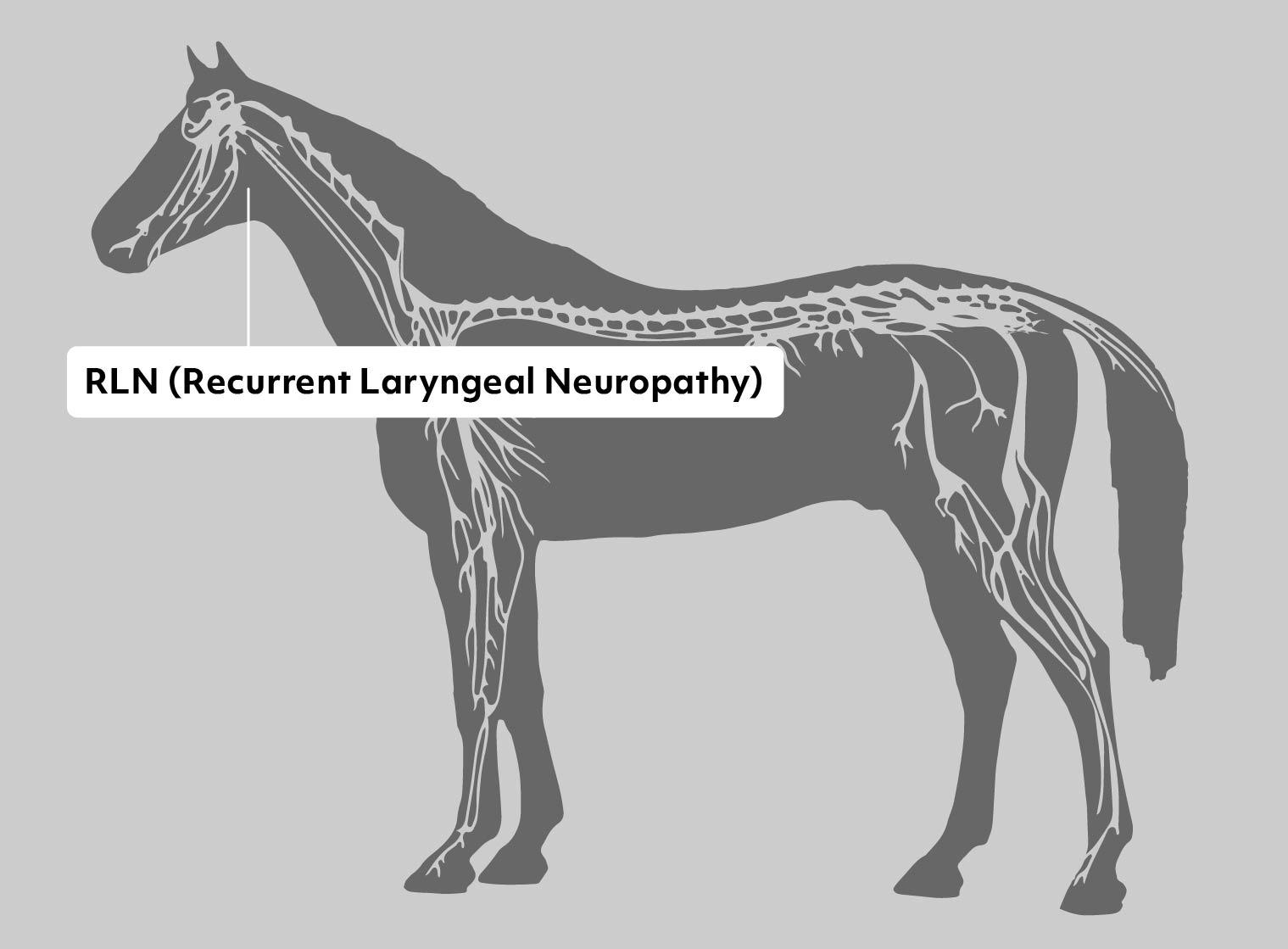Recurrent Laryngeal Neuropathy (RLN)
Gene or Region: ECA3
Reference Variant: T
Mutant Variant: C
Affected Breeds: Many
Research Confidence: High - Strong correlation in larger studies
Explanation of Results: RLN/RLN = homozygous for Recurrent Laryngeal Neuropathy Risk, ~12x higher risk than n/n RLN/n = heterozygous for Recurrent Laryngeal Neuropathy Risk, ~5x higher risk than n/n n/n = no variant detected
General Information for Recurrent Laryngeal Neuropathy
Recurrent Laryngeal Neuropathy (RLN) commonly called "Roaring" is a disease that results in loss of the neurons that open the larynx. Although we do not know what causes RLN, it significantly affects performance in Thoroughbreds and other sport horses. In technical terms, RLN represents a distal axonopathy of the recurrent laryngeal nerves, which is tpically expressed only on the left side of the larynx (the left nerve is the longest nerve in horses). RLN is also a mononeuropathy, as other peripheral nerves of the horse remain unaffected. RLN is an important issue for horses in competitive events, because the resultant paralysis of the larynx leads to obstruction of air flow during intense exercise. This obstruction creates the abnormal inspiratory noise that gives RLN its common name: “roaring.” Horses with RLN cannot breath normally at speed and as a result don't perform to their full potential. RLN has particular economic importance in Thoroughbred racehorses because these animals enter race training as 2-year-olds. Even though many thoroughbred horses sold at auction are endoscopically examined for evidence of RLN, the condition tends to develop with age, and may not yet be clinically evident in young animals.
A genetic contribution to the pathogenesis of RLN was previously suggested by the higher prevalence of the condition in offspring of RLN-affected than unaffected stallions. A 2014 study concluded that geldings are at higher risk than mares or stallions, and noted association to a site in the genome that also contributes to height.
References
Boyko et al., “Genomic analysis establishes correlation between growth and laryngeal neuropathy in Thoroughbreds.” (2014) BMC Genomics. 15:259. PMID: 24707981
Figure 1 from: “Equine Welfare during Exercise: An Evaluation of Breathing, Breathlessness and Bridles”, Mellor and Beausoleil, Animals 2017, 7(6), 41; doi:10.3390/ani7060041
More Horse Health
Lavender Foal Syndrome
Lavender foal syndrome (LFS), also known as coat color dilution lethal, is a neurological dysfunction in newborn foals. Symptoms are apparent at birth and include seizures, severe hyper-extension of limbs, neck and back, stiff paddling leg movements, involuntary eye movement and inability to stand or sit upright. The coat usually has a dilute color that ranges in shade from silver to a pale lavender/pink. As there is no treatment, affected foals are humanely euthanized.
Lordosis
Lordosis (L1, L2, L3, L4), also known as "Swayback", is a curvature or dip in the spine that is often seen in older horses. However, in the American Saddlebred, this condition also affects younger horses. These animals do not appear to experience pain from their condition and are still able to be used under saddle.
Malignant Hyperthermia
Malignant hyperthermia (MH) is a muscle disorder in which anesthesia, stress, or extreme exercise trigger a hyperthermic state. Symptoms include high temperature, increased heart rate, high blood pressure, sweating, acidosis, and muscle rigidity. If symptoms are not immediately resolved, death is likely to occur.
Myosin-Heavy Chain Myopathy
Myosin-Heavy Chain Myopathy (MY; previously "IMM") is a genetic muscle disease found most commonly in stock-type horses that can result in two different presentations, Immune-Mediated Myositis (IMM) and Nonexertional Rhabdomyolysis “tying up,” which are both characterized by muscle damage or loss. Both presentations are associated with the same genetic variant. Horses with MYHM may exhibit one or both presentations at different times in their lives, although some horses carrying the variant might not display any symptoms at all.
